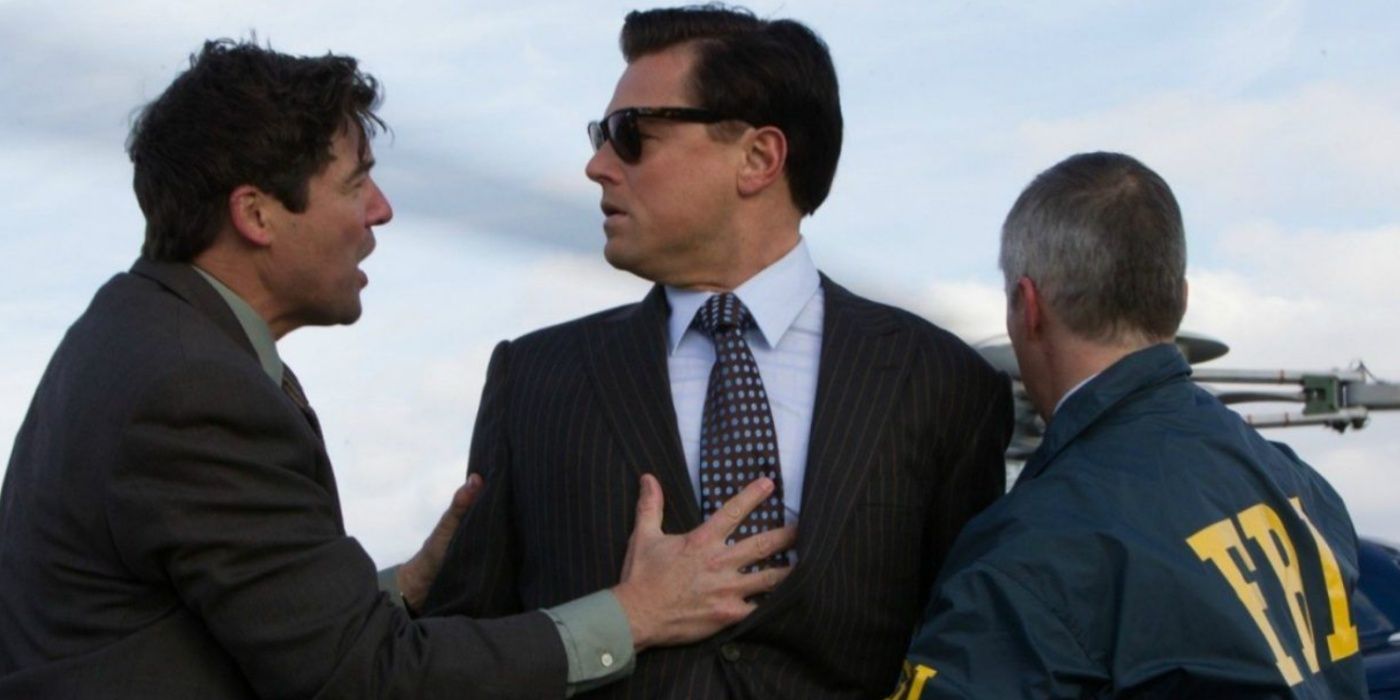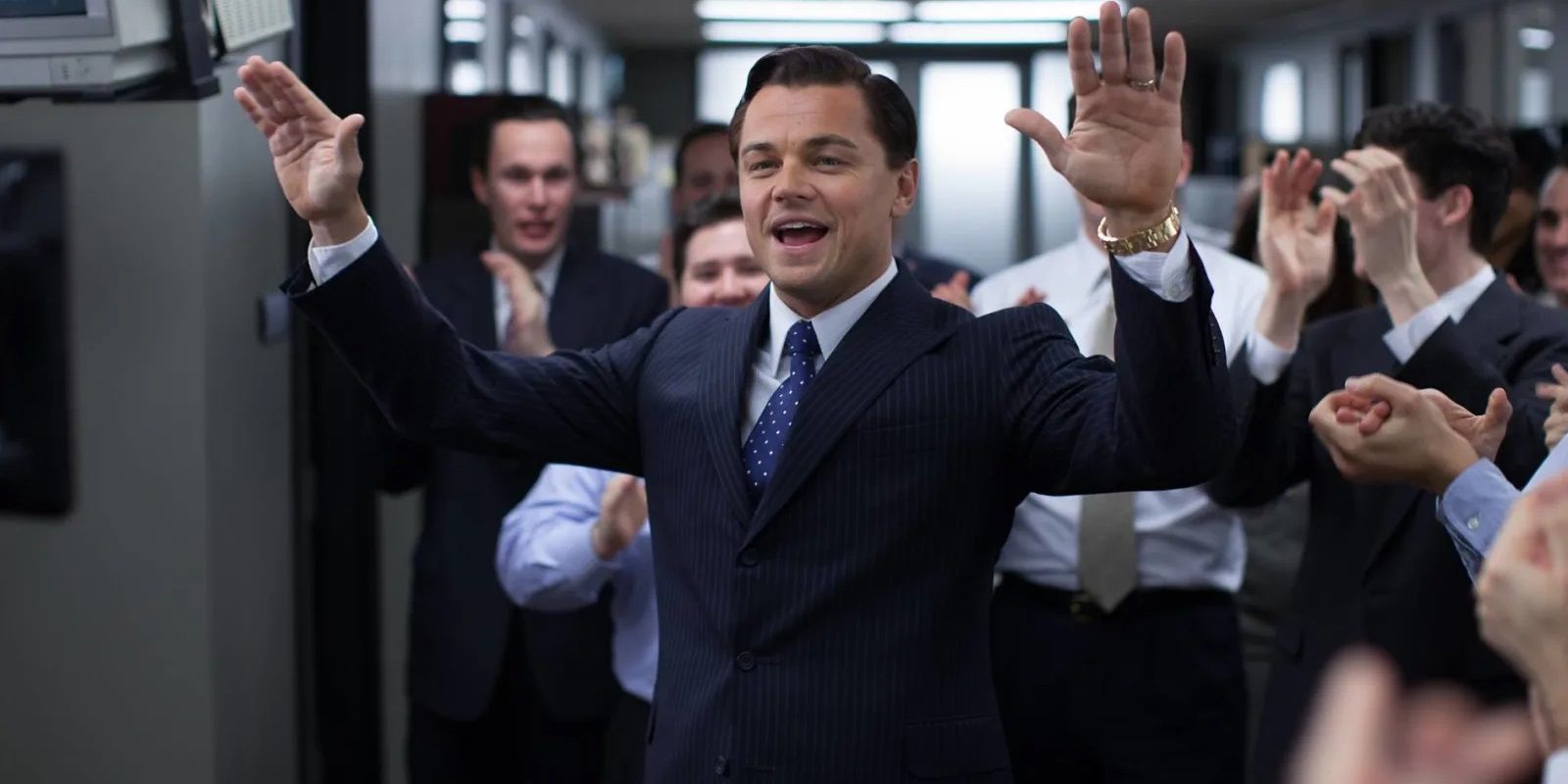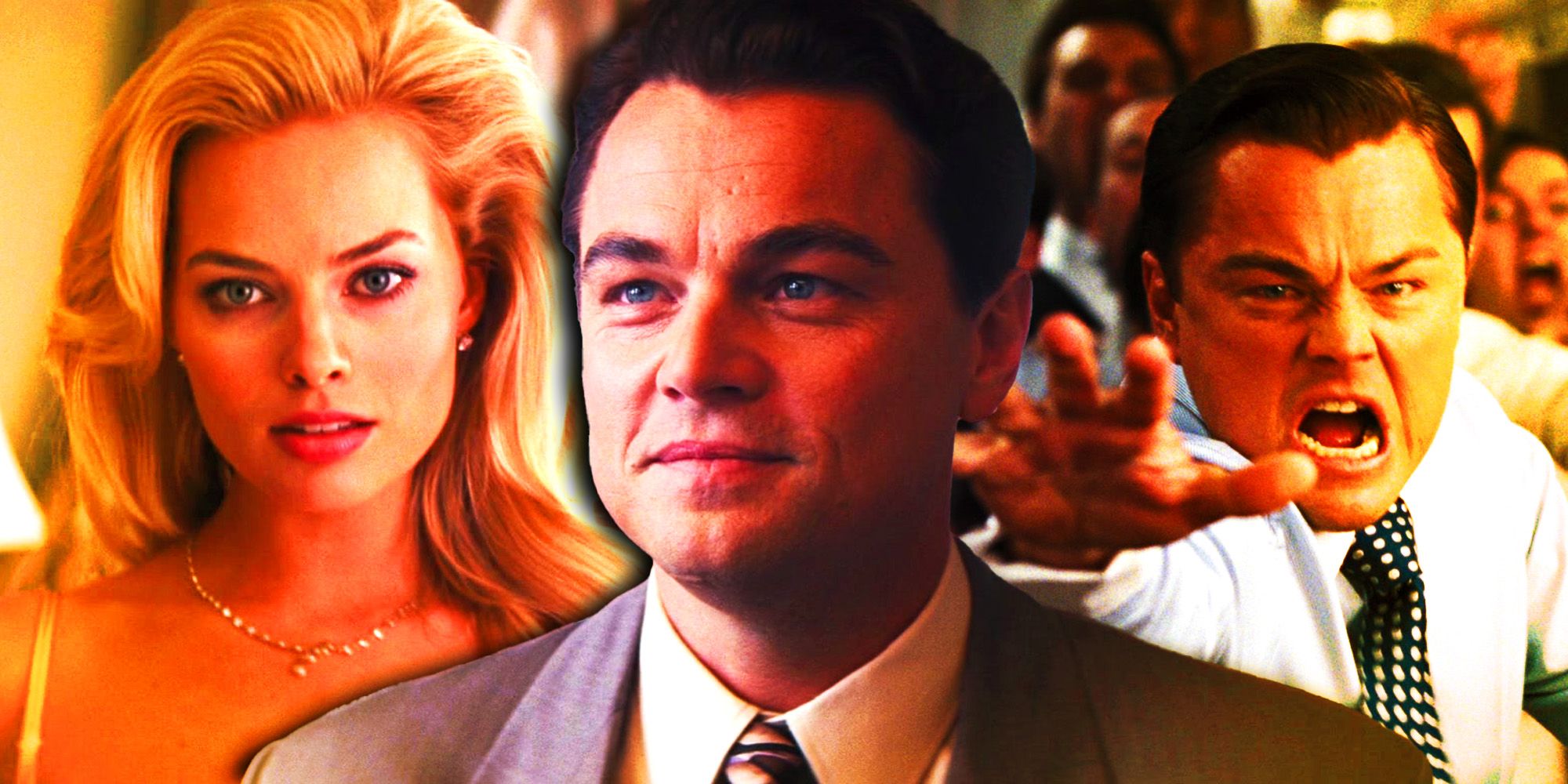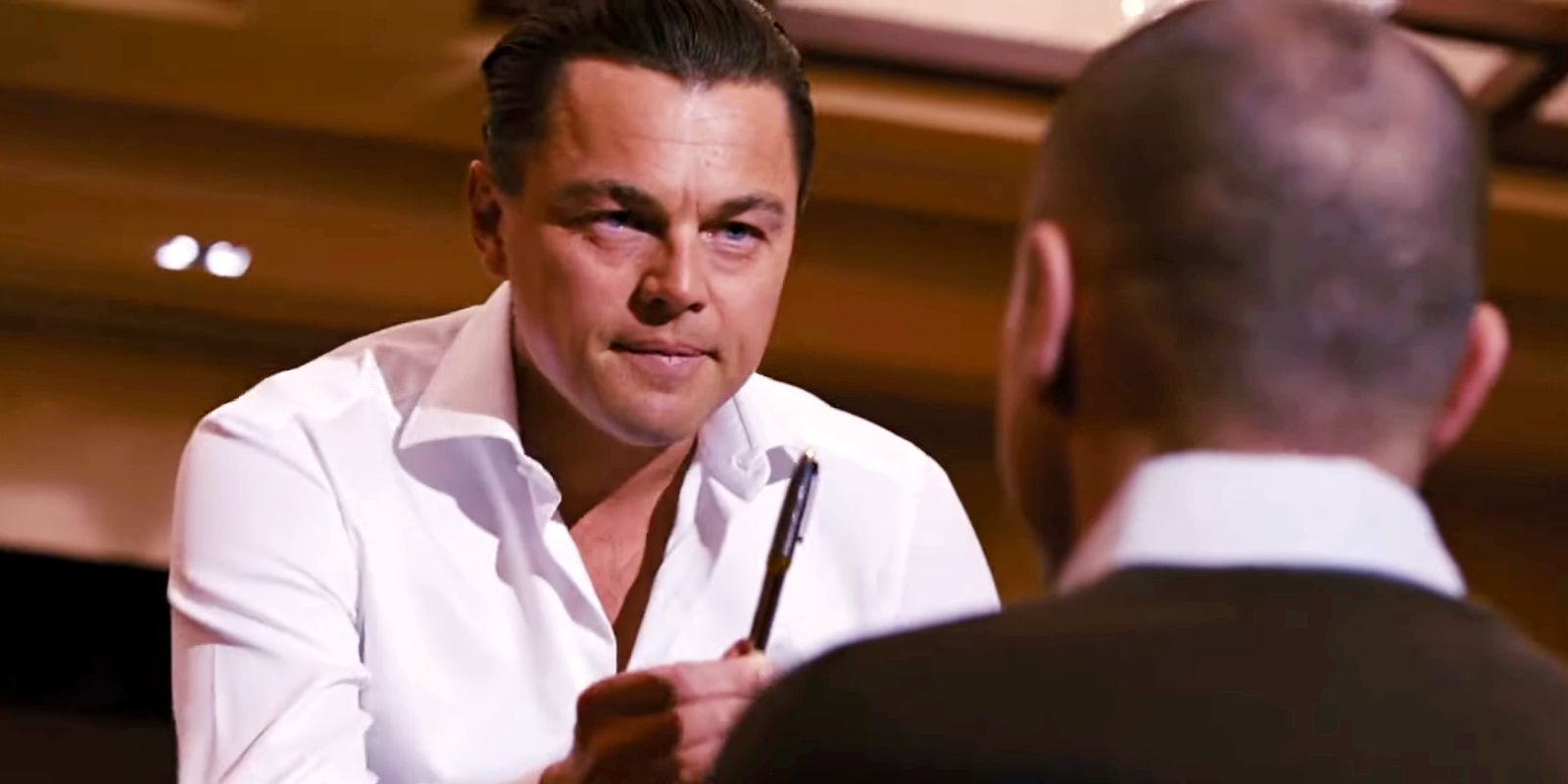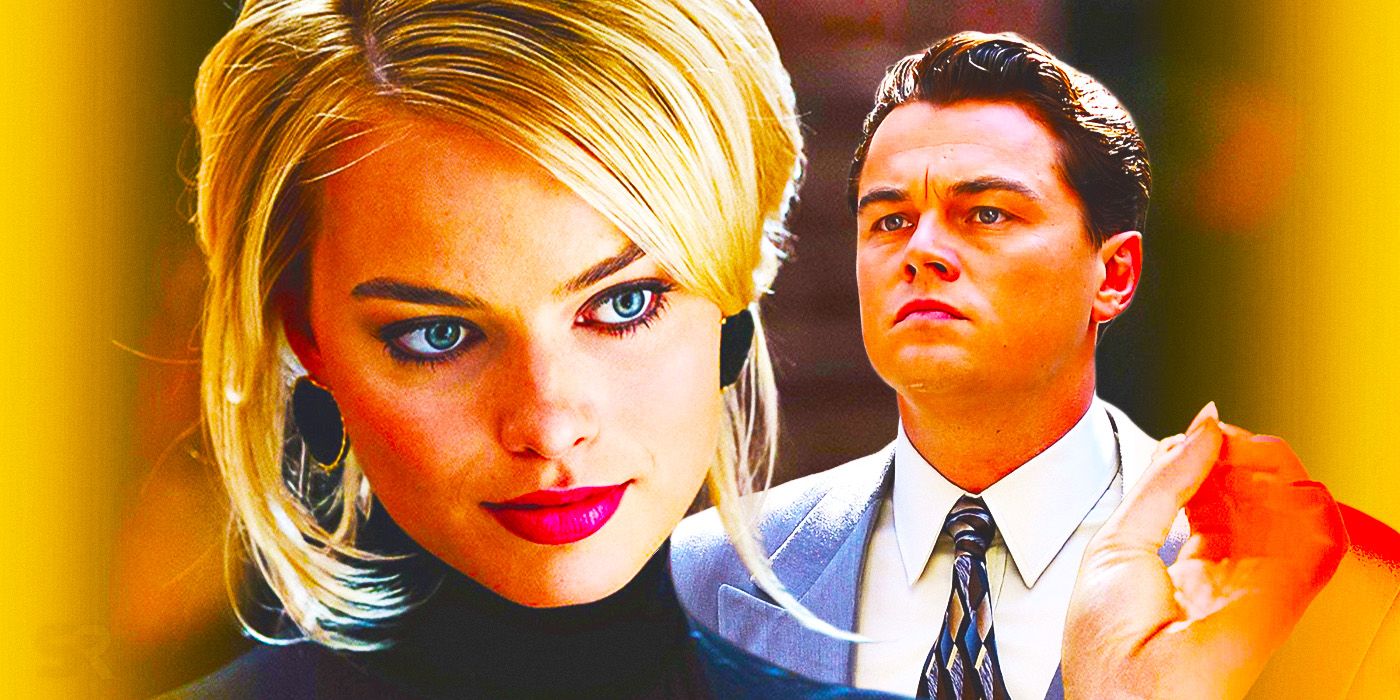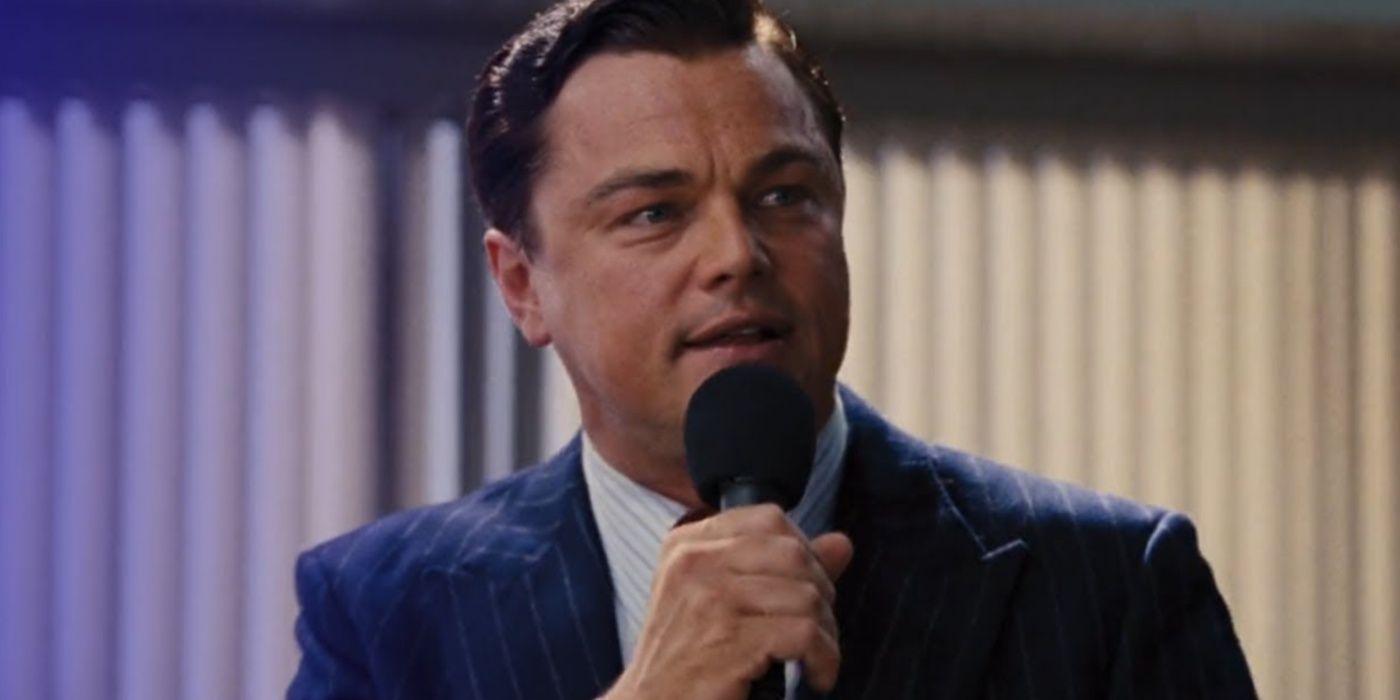The Wolf of Wall Street is a Martin Scorsese black comedy based on Jordan Belfort’s infamous tale of business fraud as a stockbroker. In The Wolf of Wall Street, Belfort (Leonardo DiCaprio) becomes a stockbroker and achieves a moderate level of financial success before losing his job in the 1988 Black Monday crash. He then founds the stock trading firm Stratton Oakmont, which quickly becomes a criminal enterprise as Belfort and his associates trick unsuspecting customers into investing in stocks without showing them the fine print.
Over its three-hour runtime, The Wolf of Wall Street follows the rise and fall of Stratton Oakmont and the wealth Jordan Belfort builds from it. It also chronicles Belfort’s tumultuous romance with his wife, Naomi (Margot Robbie), and his increasingly out-of-control drug addiction. Belfort spends much of The Wolf of Wall Street barely keeping one step ahead of the FBI before finally being forced to turn himself and his company over in The Wolf of Wall Street‘s ending.
Related
21 Best Wolf Of Wall Street Quotes
Martin Scorsese and Leonardo DiCaprio struck black comedy gold with 2013’s The Wolf of Wall Street, but which quotes are the best?
Jordan Belfort’s Arrest & Imprisonment Explained
Various Deals Led To A Shorter Sentence
As Belfort finally begins to break his drug addiction after a near-death experience aboard his yacht in Italy (which he himself causes by ordering the yacht to sail to Monaco during a storm), the authorities get the jump on him when his French banking associate Jean-Jacques Saurel (Jean Dujardin) is arrested. After Saurel sells out Belfort, he takes a plea deal to round up evidence on his Stratton Oakmont colleagues in exchange for a lesser sentence.
During a conversation with his partner in crime Donnie Azoff (Jonah Hill), Belfort tips his friend about the investigation. Unfortunately for Belfort, the FBI learns of his warning, which is a major breach of his plea deal. Nonetheless, at the end of The Wolf of Wall Street Jordan receives a relatively light sentence of 36 months in a minimum-security prison, and he’s released after just 22 months.
What Happens To Jordan & Naomi’s Marriage
Cocaine Abuse Ruins Belfort’s Family Life
Belfort and his wife, Naomi, initially have a quite happy marriage. However, it soon devolves into the two regularly arguing and swearing at each other over Belfort’s illicit activity, extramarital affairs, and drug abuse. This comes to a head during The Wolf of Wall Street ending when Belfort is caught by the SEC and FBI, with Naomi telling Jordan that she is divorcing him and taking custody of their two children.
The infuriated Belfort then swiftly relapses into his cocaine use. After punching Naomi in the stomach, he tries to leave the house with his young daughter. Belfort is in a warped rage and high on cocaine, so he doesn’t get far and simply crashes his car while pulling out of the driveway. Fortunately, he does so without hurting his daughter. Naomi takes their daughter back, and Belfort is left to ponder how much he has ruined his own life.
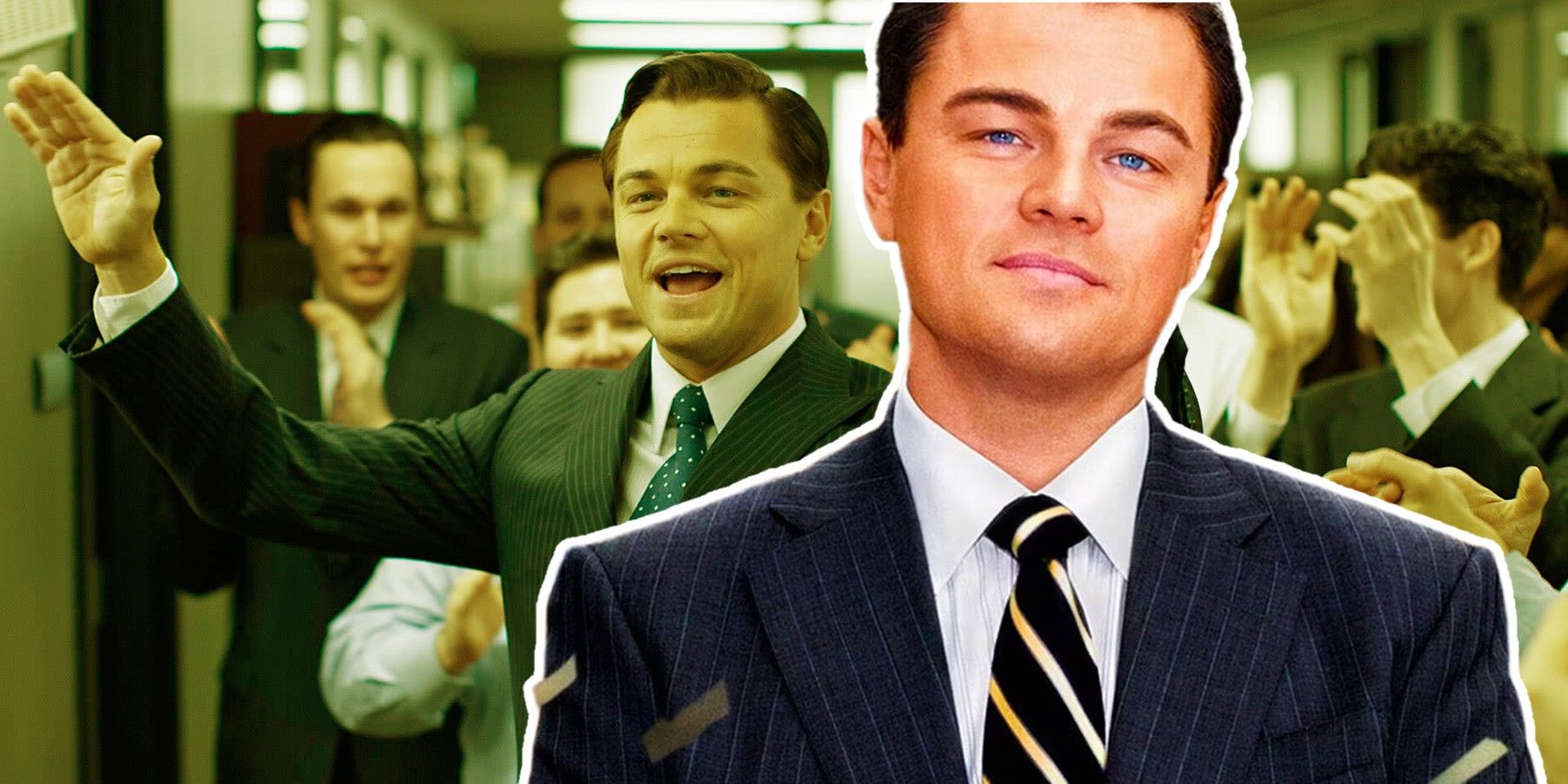
Related
Every Song In The Wolf Of Wall Street
With a wide variety of songs from a handful of different genres, The Wolf of Wall Street has one of Martin Scorsese’s most ambitious soundtracks.
Stratton Oakmont’s Future Explained
Befort’s Business Was Swiftly Shut Down
Stratton Oakmont’s business model was based on what is known as a “pump-and-dump” scheme, in which Jordan and his fellow stock traders greatly exaggerate the value of stocks to sell them at higher prices. After the customer buys the stocks, the price of the stock drops, with the customer defrauded of their money and Stratton Oakmont making a large profit. Needless to say, this is a highly illegal form of stock trading, and Stratton Oakmont’s unusually swift rise attracts the attention of both the SEC and the FBI.
As the authorities begin to close in on Stratton Oakmont towards the ending of The Wolf of Wall Street, Belfort makes a barely disguised attempt to bribe the feds with “fun coupons,” his slang term for money. However, the ruse is up altogether by the time he is forced to become an FBI informant. After Belfort’s testimony against his co-conspirators, the FBI shuts down Stratton Oakmont.
What Happens To The Real Characters After The Wolf Of Wall Street’s Ending
Jordan Belfort Is Now A Motivational Speaker
The movie’s ending raises questions about what happened to the real Belfort after The Wolf of Wall Street. After serving his 22-month sentence, the real Belfort was released from prison in 2006. He has since become a motivational speaker and written two books on his time running Stratton Oakmont, one of which — The Wolf of Wall Street — served as the basis for Scorsese’s film. Additionally, Belfort has also become a cryptocurrency investor.
Jordan’s ex-wife, Nadine Macaluso, who was the basis for Margot Robbie’s Naomi, has since gone on to work as a therapist and marriage counselor. Macaluso has also spoken on abusive relationships, and she is the author of the book Run Like Hell: A Therapist’s Guide to Recognizing, Escaping, And Healing From Trauma Bonds. Additionally, Macaluso consulted with Margot Robbie and her accent coach for The Wolf of Wall Street to help develop Robbie’s accent as Naomi.
Azoff is an analogue for Belfort’s real-life Stratton Oakmont associate Danny Porush, who was convicted alongside Belfort and served 39 months in prison. After his release from prison, Porush went on to work for Med-Care Diabetic & Medical Supplies. Porush himself later faced further fraud allegations amid claims that Porush and others at Med-Care had tried to fraudulently sell medical supplies to companies, though Med-Care pushed back with a countersuit.
What Jordan Belfort’s “Sell Me This Pen” Challenge Means
The Simple Exercise Demonstrates The Importance Of Supply And Demand
In The Wolf of Wall Street‘s final scene, Belfort has begun a new career teaching seminars on sales techniques, with the real Belfort even making a cameo introducing his on-screen counterpart. Drawing upon an earlier scene in the movie, Belfort approaches each attendee holding a pen in his hand and simply demands, “Sell me this pen.” As each attendee makes a failed sales pitch to Belfort, he takes the pen back and poses the same question to the next audience member.
The earlier scene in the movie sees Belfort demonstrating the same trick by handing a pen to his friend, Brad Bodnick (Jon Bernthal), who then asks Belfort to write his name down. When Belfort says he doesn’t have a pen, Brad replies, “Exactly. Supply and demand.“ The ending of The Wolf of Wall Street pays this off by showing, in a sly way, that the key to Belfort’s success was all about enticing customers with something they didn’t have, even if the sale itself was bogus. While the seminar attendees focus on making the pen itself look good, Belfort’s sales methodology is both simple and elusive to all of them.
What The Wolf Of Wall Street’s Ending Changes from Belfort’s Real Life
There Are Several Moments With Dubious Accuracy
With respect to the accuracy of The Wolf of Wall Street, Belfort has said that his drug addiction was significantly worse in real life. By Belfort’s own account, he was addicted to up to 22 different drugs at one point. Additionally, per the real Belfort, the outrageous, drug-fueled shenanigans in the Stratton Oakmont office seen in The Wolf of Wall Street are also very accurate.
Macaluso has also stated that the movie portrays her marriage to Belfort truthfully. However, both Belfort and Macaluso have given different descriptions of the scene in which Belfort assaults Naomi. Through her TikTok, (via Daily Mail UK), Macaluso has claimed that, rather than punching her, Belfort burned her clothes and kicked her down a staircase after she insisted he go to rehab. She also said that she did not threaten to take their kids from him, but that Belfort instead said he was going to Florida with their daughter.
Belfort has provided a somewhat different account of this incident and also says he did not punch Macaluso. Jordan has stated (via The Guardian) that “it was more of a struggle where she grabbed onto my leg and I kicked out,” while acknowledging that “it was awful what I did” and he was on “massive quantities of drugs.” At any rate, Macaluso has said that she and her ex-husband are “all okay today.” According to her, Belfort even paid her a visit on the day of The Wolf of Wall Street‘s 2013 release.
The Real Meaning Of The Wolf Of Wall Street’s Ending
The Satirical Comedy Carries An Anti-Greed Message
Above all else, The Wolf of Wall Street is a cautionary tale against the intoxicating power of greed, though it delivers its message in the form of a hilarious black comedy. When Belfort begins his narration in the opening of The Wolf of Wall Street, he is a cocky, self-absorbed party animal barely concerned about the ramifications of his illegal activity. He’s more perturbed that he only earned $49 million the previous year (“three shy of $1 million a week,” as he observes). With Belfort outright bragging about the number of drugs he takes in the movie’s opening, excess also goes hand-in-hand with his avarice.
For all the wealth he accumulates through Stratton Oakmont, Belfort is never really happy unless he is high on drugs, and he also treats money in much the same way. His ultimate downfall — and that of Stratton Oakmont — are both a byproduct of the same impulse.
For all the wealth he accumulates through Stratton Oakmont, Belfort is never really happy unless he is high on drugs, and he also treats money in much the same way. His ultimate downfall — and that of Stratton Oakmont — are both a byproduct of the same impulse. Belfort and his cohorts are constantly chasing the high that both money and drugs give them, no matter the harm they cause to themselves or others. In the end, Belfort learns some valuable lessons about greed and excess in The Wolf of Wall Street, though he remains a master salesman, as his pen trick shows.
How The Wolf Of Wall Street Ending Was Received
The Final Scenes Weren’t The Highlight Of The 2013 Biopic
Overall, The Wolf of Wall Street was both a critical and commercial success. The 2013 movie currently holds a 79% Tomatometer score and 83% Popcornmeter score on Rotten Tomatoes, showcasing how much it resonated with both general audiences and critics. The film wasn’t without its controversies of course, as there were many who found certain scenes gratuitous or took issue with the pacing and subsequent 3-hour runtime. However, for the most part, Martin Scorsese’s satire was met with praise.
Many critics celebrated how the final scenes of the movie wrapped up many of its core themes, specifically those of addiction and how it ultimately leads to downfall, incredibly well.
While the ending of The Wolf of Wall Street and wider plot did crop up in many reviews, especially when it came to accuracy and how it portrayed Jordan Belfort as a character, most of the focus was on the deeper themes of the story and the performances. Leonardo DiCaprio in particular was the subject of most of the analysis, which is understandable given that he portrayed the controversial central figure. Margot Robbie, Matthew McConaughey, and Jonah Hill were also frequently mentioned in a positive light. This is notable, as it illustrates that The Wolf of Wall Street could have left a much less impactful legacy had the cast not been so strong.
When it comes to how the ending of The Wolf of Wall Street was received specifically, there’s one key area of praise that repeatedly crops up in reviews. Many critics celebrated how the final scenes of the movie wrapped up many of its core themes, specifically those of addiction and how it ultimately leads to downfall, incredibly well. However, even then the conversations created by The Wolf of Wall Street ending are less about the cinematic aspects of the final scenes, and more about the central message they convey. For example, critic Matt Zoller Seitz writing for Roger Ebert had the following thoughts on the moral takeaway once The Wolf of Wall Street’s credits start to roll:
After a certain number of decades, we should ask if the nonstop enabling of addicts like Belfort doesn’t mean that, in some sense, their enablers are addicted, too—that they (we) are part of a perpetual-motion wheel that just keeps turning and turning. In the end “Wolf” is not so much about one addict as it is about America’s addiction to capitalist excess and the “He who dies with the most toys wins” mindset, which has proved as durable as the image of the snarling gangster taking what he likes when he feels like taking it.
Ultimately, there are many moments in The Wolf of Wall Street that ensured Scorsese’s 2013 movie will always remain a career highlight. The ending, while satisfactory, also isn’t one of them. It was a somewhat predictable conclusion, especially since it’s based on a true story, and Belfort’s crimes and addictions catching up with him was always going to be the suitable point to end the narrative. It wasn’t a bad ending by any stretch, but it also wasn’t the highlight of The Wolf of Wall Street either.
Source: Daily Mail UK, The Guardian
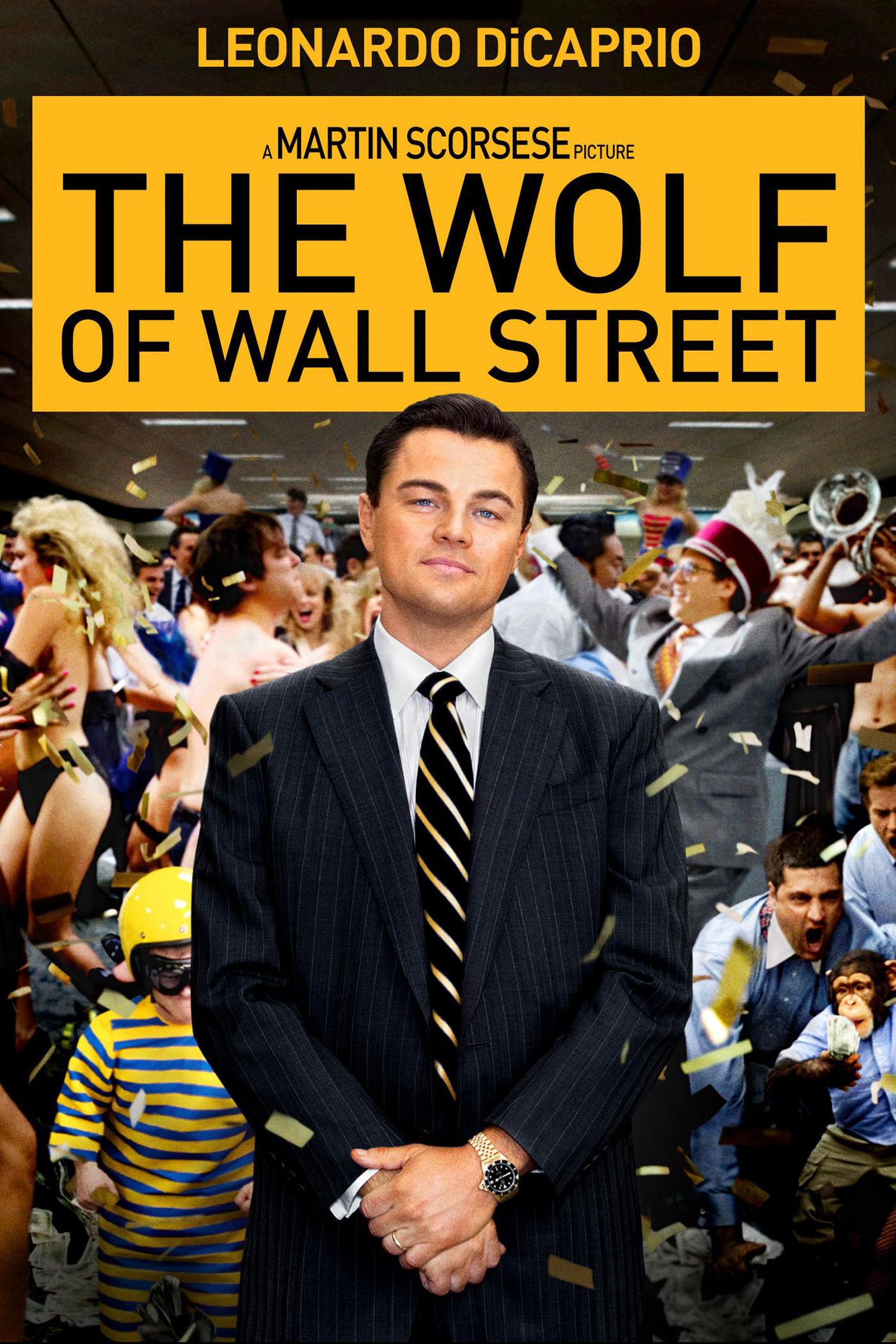
Directed by Martin Scorcese, The Wolf of Wall Street tells the true story of stockbroker Jordan Belfort (Leonardo DiCaprio), based on his memoir of the same name. It chronicles the rise of Belfort and the subsequent corruption of his firm as he engages in a wide assortment of criminal acts while amassing a staggering fortune. Jonah Hill, Margot Robbie, and Kyle Chandler also star alongside DiCaprio.
- Runtime
-
180 Minutes
- Writers
-
Terence Winter
- Studio(s)
-
Paramount Pictures

